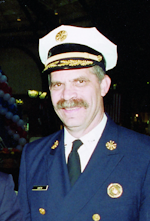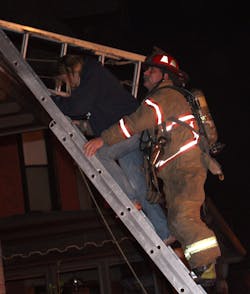There is nothing more frustrating or that produces such a feeling of helplessness than not finding a trapped occupant in a fire building. At one particular fire, we searched in zero visibility with no success for two children who slept in a third-floor bedroom. Their bodies finally were located in a knee wall area. They entered the space through a hole in the plaster wall in their closet. It later was learned that the location often was used as a play area.
The most important function of a firefighter is life safety. Fireground commanders and firefighters alike want to give trapped occupants the benefit of the doubt. If there is any chance that they can be rescued, a concerted effort to reach them will be made.
We must find out where the people are located in a fire building, who are the most threatened, and what is the quickest and safest way to reach them? Other questions include: What is the safest way of protecting occupants? Can those who are trapped be protected in place?
Search and rescue
Preplans or quick-action plans can provide the normal times that a commercial building is occupied, the number of people who usually are in the structure, a floor layout and any building protective systems. Normally, there are no preplans for private residences. Occupants should be anticipated at all times.
Dispatch information can be invaluable to responding units. Dispatchers routinely should ask what is burning and whether everyone is out of a building. Although some departments routinely update responding units, others transmit additional data only when it’s requested from the incident scene. A procedure must be established to transmit all pertinent information to the incident commander (IC).
Occupants can be a good source of information of the probable location of anyone who still is in a building. However, because of their excitement and confusion, inaccurate information can be given. Any information that’s gathered should be collated by the IC or a person that the IC designates.
The fact that many reports of people trapped in a burning building turn out to be false can be because of various factors. For example, the fire prevention message for those who practice home fire drills to have a designated place to assemble on the outside usually isn’t followed.
Also, there is the tendency for people to call their pets by name and to refer to them as their children. Terms such as “baby” or “honey” seem to indicate that a person, rather than an animal, still is within a burning property.
Window stickers can indicate a child’s bedroom, but these stickers can be misleading: Rooms might be changed during renovations, children can grow up and move out, and houses can be sold yet the stickers remain in place.
Primary and secondary search
The primary search certainly is most important. It must be as thorough as possible. Every area should be checked. Any search will be enhanced greatly when performed with a thermal imaging camera (TIC).
A primary search always is necessary. Information that no one is at home can prove faulty. The excitement of a fire can cause memory lapses of a child’s friend or a relative who is spending the night. Would-be rescuers—whether neighbors, passers-by or police officers—could be overcome and also might need to be rescued.
A search of the interior must be performed in a coordinated and systematic way. The area around the fire and directly above the fire should be checked first. This allows removal of the most seriously endangered occupants. Also, it can give the IC a good interior assessment of the conditions in these areas. If fire extends to one of these locations, it allows the IC to adjust tactics.
The company officer ordinarily will assign firefighters particular areas to search. Firefighters who perform search and rescue must not enter a building without the knowledge of their company officer. This notification is necessary for accountability of members.
A one-directional search of a room should be made by keeping close to the walls and reaching out as the room is circled. The searcher continues in the same direction (referred to as a right-hand or left-hand search) until returning to the starting point. Listening for sounds can help to locate victims. Children crying, moaning or coughing can allow firefighters to pinpoint their location.
Thermal imaging allows search and rescue crews to locate victims and to maintain contact between crew members. Like any piece of equipment, the TIC must be checked for proper operation. If this check isn’t performed prior to a response, it must be done either en route or on arrival and prior to leaving the apparatus.
Proficiency at using a TIC comes with practice. There have been instances when a firefighter was unfamiliar with the operation of the TIC or the batteries weren’t charged. That is unacceptable.
Furniture must be checked under and behind. Large bureau drawers can be children’s hiding places during playtime, and a child might seek shelter there during a fire. If a bureau drawer is open, it should be checked. After checking along the walls, the interior of the room should be checked.
Closets and bathrooms often become hiding places for victims. In closets, they might seek shelter from the smoke under clothing within. Water from a shower often is turned on for protection. After an area is searched, the IC should be notified of the results. The room should be marked to indicate that a primary search was made.
The secondary search is done to ensure that no stone is left unturned. It covers the entire structure, both on the interior and exterior. It also allows for the examination of all debris for the possibility of a victim.
It is a good habit to rotate crews for the primary and secondary searches. This ensures that different teams search all areas.
VEIS
A system to search rooms where occupants are suspected can begin from the outside through a window. The steps in the system are to vent, enter, isolate and search, or VEIS. The window to the room must be vented by opening or breaking out the glass and fully clearing the opening, to allow fast egress if necessary.
Venting of the window increases the air flow into the building and could provide additional oxygen to the fire. At the same time, the heat, smoke and fire will be drawn to the window from the fire area, which creates a flow path to the firefighter. Because the firefighter will be operating at great risk, that individual must decide whether an occupant of the room still might be alive considering the interior conditions. If the firefighter decides to enter the room, the firefighter must coordinate with interior crews, so they know the individual’s location. As soon as the room is entered, the firefighter must shut the door to the room to isolate it from the rest of the building. This action protects the firefighter and any occupants of the room by interrupting the flow path and reducing the oxygen that’s flowing to the fire.
Hoseline protection
The optimum search is made under the protection of a hoseline. Realistically, this doesn’t occur always because of the many areas that must be searched in as short of a time as possible. Thus, search and rescue teams often operate under extreme conditions. The importance of full PPE with SCBA is obvious. If possible, each member of a search and rescue team should carry a hand tool, light, portable radio and a TIC.
When search and rescue crews depend on a hoseline to contain a fire to a specific area, they should ensure that the hose crew is aware of their location and their dependence on the hoseline. Coordination between hoseline crews and rescue teams is critical when crews go to an upper floor via an interior stairway before the fire is controlled on a lower floor. If for any reason the hoseline can’t contain the fire and a backup line hasn’t arrived or members are ordered out of the building, the rescue crews that operate above must be notified immediately.
When a search is completed and search and rescue crews leave the endangered area, hoseline crews must be informed. This must be done when rescue crews exit where they entered but particularly when they leave by another exit.
Victim removal
When victims are located, consider whether they can be removed through the interior of the building in relative safety. More people can be evacuated quickly and safely this way than by using ladders. Often, it is easiest to remove someone who has been overcome and is endangered seriously by the fire by dragging the individual along the floor. This also keeps the person below the heat and smoke.
The use of ladders in performing rescues can cause problems. People already are in a state of shock. Young children must be carried. The fear of an unknown person wearing SCBA might cause a struggle. If a victim is unconscious and regains consciousness while being carried down a ladder, the individual might react by struggling and possibly fall or cause the rescuer to fall. Fear of heights must be anticipated.
The removal of an obese individual who you realistically wouldn’t be able to carry down a ladder can pose problems. In these cases, the person who is trapped might need to be protected in place until it is safe to proceed through the interior and, if required, to use an oversized stretcher or backboard to carry the person or slide the stretcher along the floor to the exterior.
With all of the drawbacks, there still are numerous instances where rescue by ladder (or a platform) will need to be performed. However, ladder operations tend to be slow, because they provide exit from only one window. When many rescues are required, the most endangered must be attended to first.
Critical decision-making
The initial IC who arrives on scene where numerous people are endangered will have critical decisions to make, including where fire department’s efforts will do the most good, considering staffing and resources that are responding and their anticipated arrival time. These decisions may entail dedicating all personnel to rescues. Command may decide that a hoseline must be pulled to contain a fire to a specific area as a life-saving tactic.
There can be more than one right way. A large metropolitan department that has a response of six or more units that have predetermined duties and adequate staffing can predict more easily specific duties and handle multiple rescues. A small department that has a limited number of units responding and a minimum number of firefighters on each apparatus might need to use different strategies.
Exterior Search
A n operation shouldn’t be considered complete until a thorough search is made of the exterior of the structure. Incidents have occurred where shrubbery and fire debris that was thrown from windows covered individuals who jumped from an upper floor, unbeknownst to firefighters.
Alternate Escape Routes
Constant thought must be given to an alternate escape route, no matter where the search and rescue team is located in the building. This is an individual thought process that must start on arrival at the scene. Features of the building should be memorized, including: the number of stories; the location of fire escapes; different roof levels that would allow for easy exit from a window; the presence of window air-conditioners or steel bars on windows or other obstructions that could prevent exit.
With the information gathered, firefighters should try to envision their approximate location within the building at all times. Communications between members should point out these potential secondary escape routes.

James P. Smith
JAMES P. SMITH, who is a Firehouse contributing editor, is a retired deputy chief of the Philadelphia Fire Department. He is an adjunct instructor at the National Fire Academy and the author of the fourth edition of the book "Strategic and Tactical Considerations on the Fireground," which was published by Brady/Pearson.






